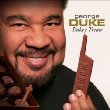Dukey Treats, features every facet of funk, soul, jazz and R&B of impresario George Duke. Say you're into that deep funk, like the groove that Duke made famous on 1970s jams such as "Dukey Stick" and "Reach For It," then you'll feel joints such as "Mercy," "Creepin (Ghoulie Remix) and "Everyday Hero." "Dukey Treats," the title track is somewhat of an homage to songs like "Dukey Stick" and "Reach For It," and not only because the song is a head nodder driven by a thumping bass; the cut features the side conversations and double entendre that Duke used to great effect in "Dukey Stick" particularly.
Dukey Treats, features every facet of funk, soul, jazz and R&B of impresario George Duke. Say you're into that deep funk, like the groove that Duke made famous on 1970s jams such as "Dukey Stick" and "Reach For It," then you'll feel joints such as "Mercy," "Creepin (Ghoulie Remix) and "Everyday Hero." "Dukey Treats," the title track is somewhat of an homage to songs like "Dukey Stick" and "Reach For It," and not only because the song is a head nodder driven by a thumping bass; the cut features the side conversations and double entendre that Duke used to great effect in "Dukey Stick" particularly.
What if you're into jazz influenced ballads, like "No Rhyme, No Reason," that Duke started to feature more and more starting in the 1990s? Then, you'll love tunes like "Listen Baby," and "Right on Time." These songs, like the up-tempo funky jams, have memorable bass lines. However, the arrangements on these slower songs employ a bass line that is more like what would be heard in a straight ahead jazz tune. On "Right on Time," for example, the bass lays down a straightforward rhythm while the piano and guitar add jazz influenced riffs.
Say you were into some of the jazz/funk/pop fusion that Duke laid down during his 1980s collaborations with Stanley Clarke. Then, you will love the delightful head-nodder "Somebody Laid It On Us." That song, along with the topical "Sudan," which is about the crisis in Darfur, reveals that Duke is also concerned about what is going on in the world.
Duke started out playing acoustic jazz in the mid-1960s. He was on the scene during the soul-jazz movement led by artists such as Cannonball Adderly and Ramsey Lewis, as well as the jazz/funk/rock fusion movement that got a big boost when Miles Davis cut Bitches Brew. The fusion influence can be heard in the tune "Images of Us." This is a song that most starkly what distinguishes fusion from smooth jazz. Like smooth jazz, fusion reconciles itself with genres such as R&B, soul and rock. However, fusion artists has never been content to give listeners the kind of easy listening-by-the-book version of R&B and pop songs that are often a distinctive feature of smooth jazz. Fusion demands that listeners understand that the genre aims to reconcile rock and funk to jazz and not the other way around. That's why a song like "Images of Us" features the kind of improvisation and back and forth among the musicians that has been a jazz staple for years.
What Dukey Treats shows is that Duke is an artist who can easily speak the language of jazz/funk/rock fusion while being equally fluent in each individual genre. Duke's goal is provide a little something for everybody. It definitely helps that Duke is a multi-lingual musician. Recommended.
by Howard (no relation) Dukes

